LEXUS RX350 2011 Owners Manual
Manufacturer: LEXUS, Model Year: 2011, Model line: RX350, Model: LEXUS RX350 2011Pages: 821, PDF Size: 13.27 MB
Page 301 of 821
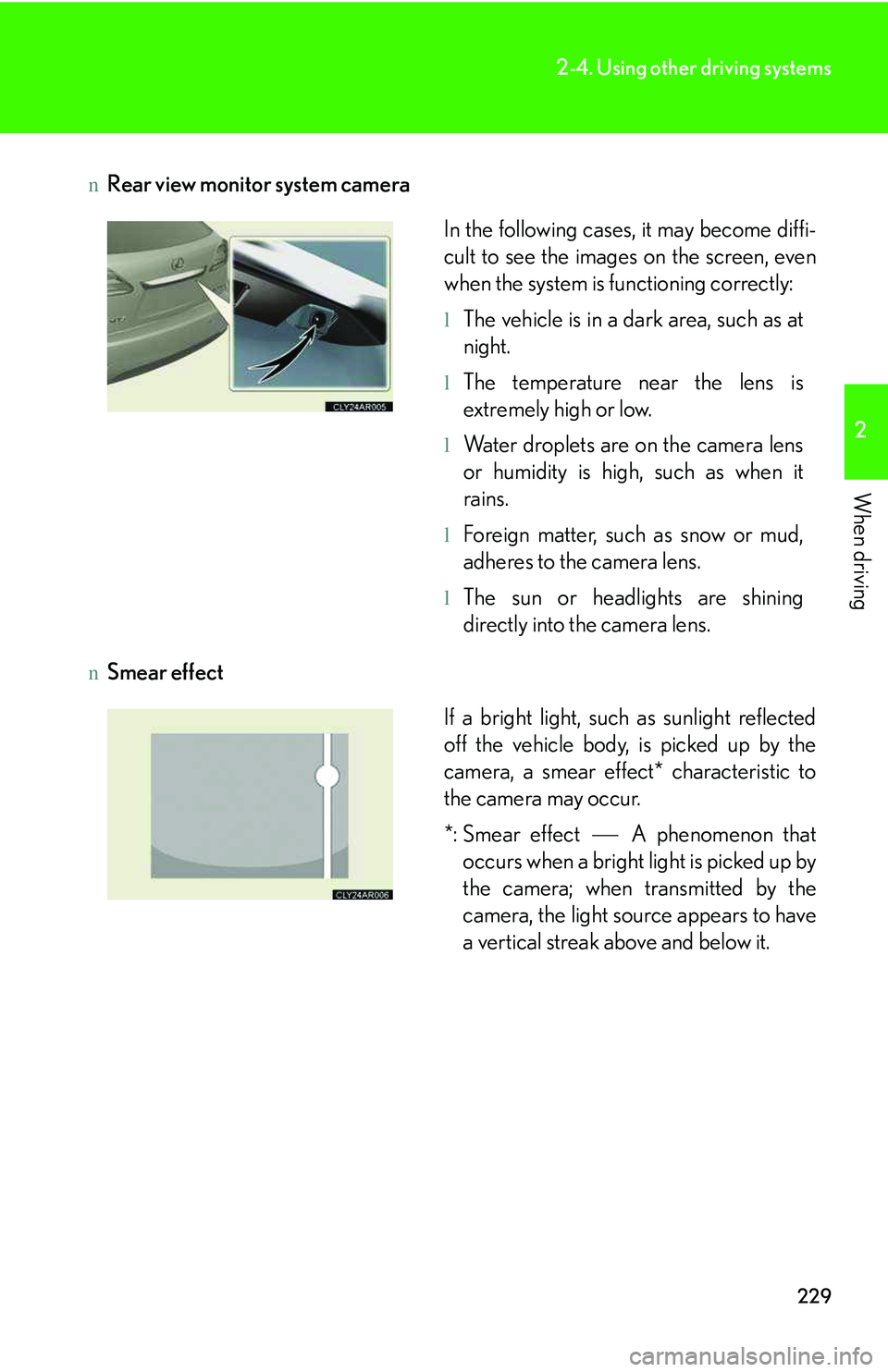
229
2-4. Using other driving systems
2
When driving
nRear view monitor system camera
nSmear effect
In the following cases, it may become diffi-
cult to see the images on the screen, even
when the system is functioning correctly:
lThe vehicle is in a dark area, such as at
night.
lThe temperature near the lens is
extremely high or low.
lWater droplets are on the camera lens
or humidity is high, such as when it
rains.
lForeign matter, such as snow or mud,
adheres to the camera lens.
lThe sun or headlights are shining
directly into the camera lens.
If a bright light, such as sunlight reflected
off the vehicle body, is picked up by the
camera, a smear effect* characteristic to
the camera may occur.
*: Smear effect� �⎯� A phenomenon that
occurs when a bright light is picked up by
the camera; when transmitted by the
camera, the light source appears to have
a vertical streak above and below it.
Page 302 of 821
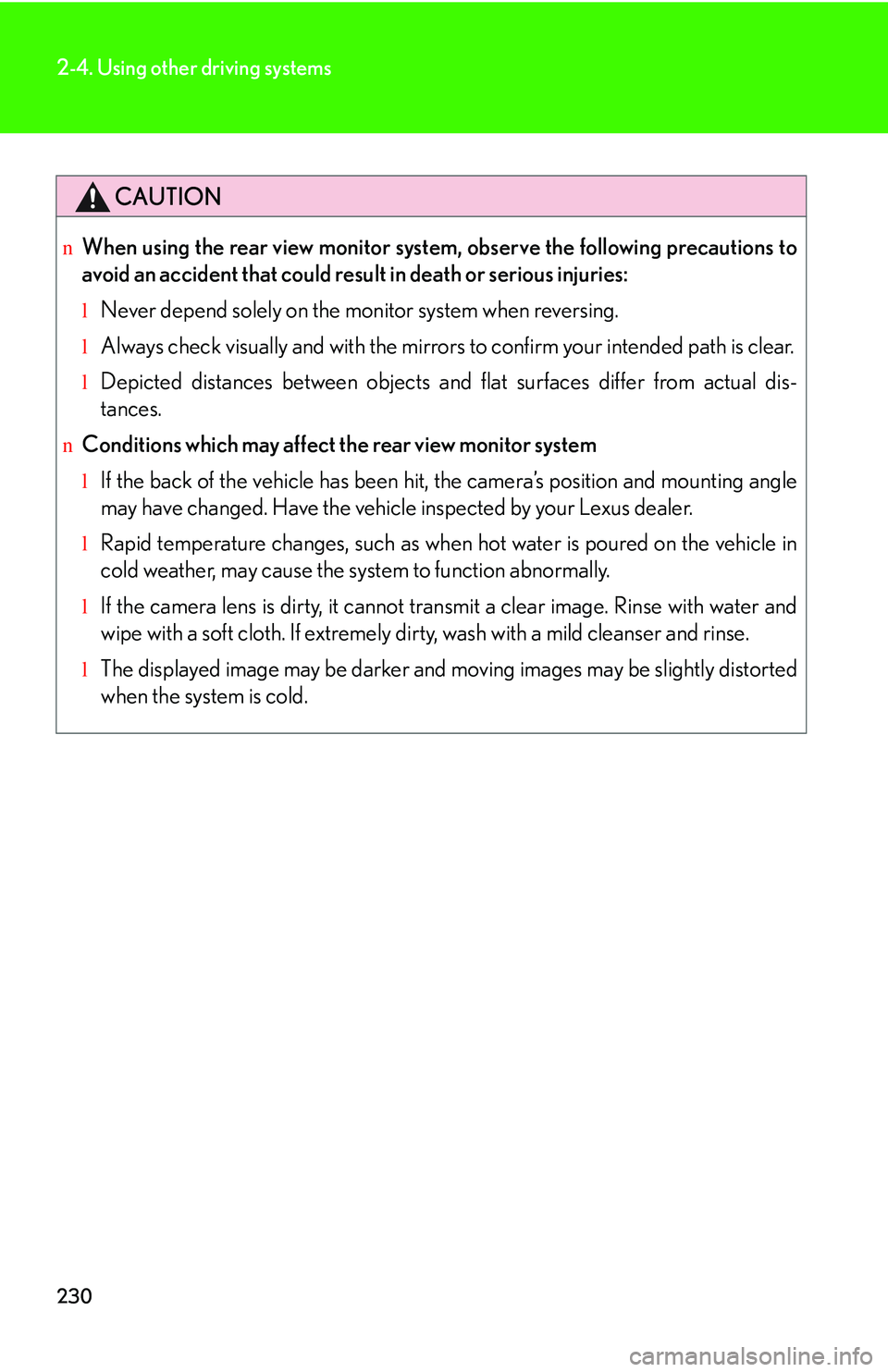
230
2-4. Using other driving systems
CAUTION
nWhen using the rear view monitor system, observe the following precautions to
avoid an accident that could result in death or serious injuries:
lNever depend solely on the monitor system when reversing.
lAlways check visually and with the mirrors to confirm your intended path is clear.
lDepicted distances between objects and flat surfaces differ from actual dis-
tances.
nConditions which may affect the rear view monitor system
lIf the back of the vehicle has been hit, the camera’s position and mounting angle
may have changed. Have the vehicle inspected by your Lexus dealer.
lRapid temperature changes, such as when hot water is poured on the vehicle in
cold weather, may cause the system to function abnormally.
lIf the camera lens is dirty, it cannot transmit a clear image. Rinse with water and
wipe with a soft cloth. If extremely dirty, wash with a mild cleanser and rinse.
lThe displayed image may be darker and moving images may be slightly distorted
when the system is cold.
Page 303 of 821
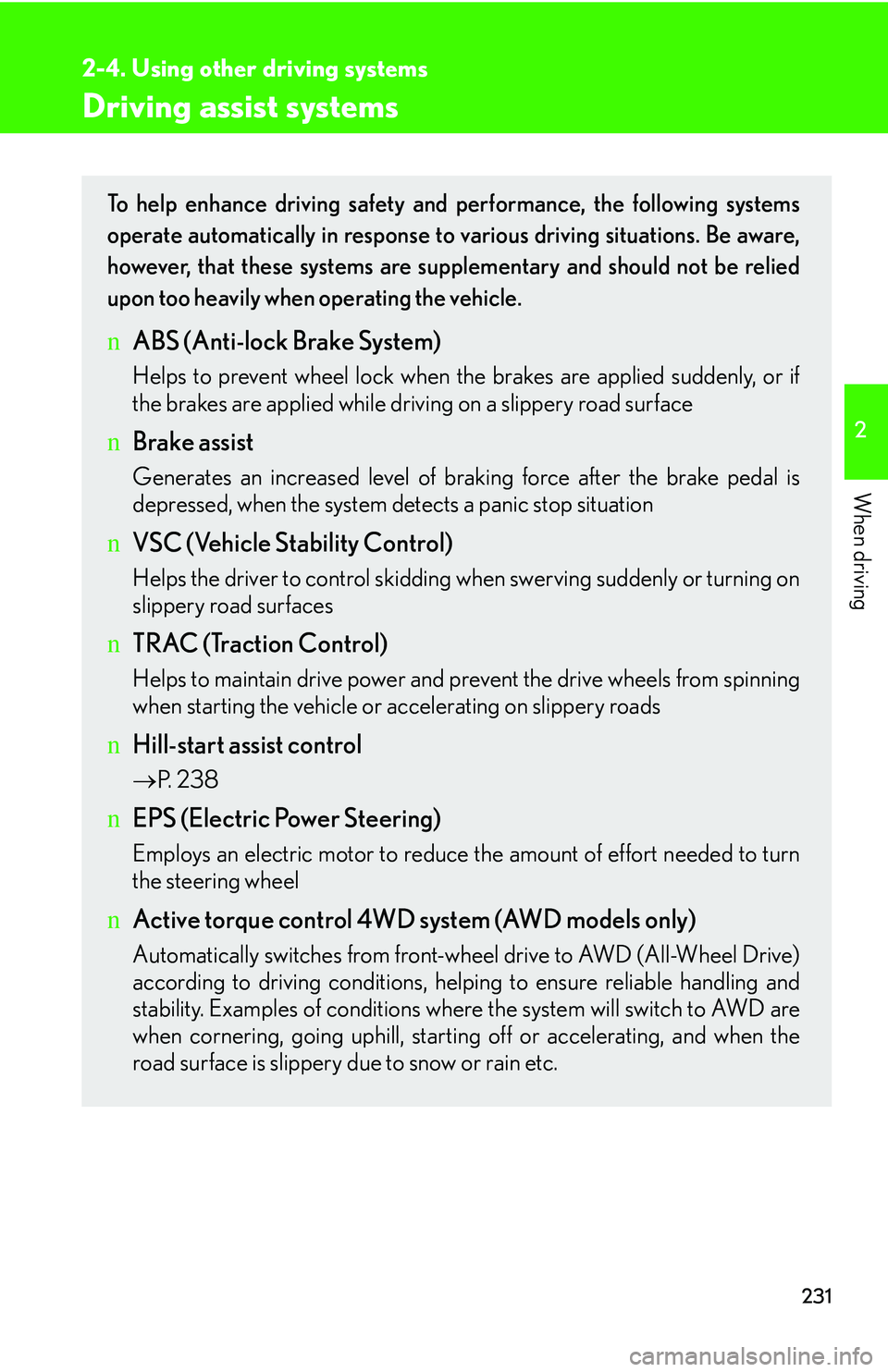
231
2-4. Using other driving systems
2
When driving
Driving assist systems
To help enhance driving safety and performance, the following systems
operate automatically in response to various driving situations. Be aware,
however, that these systems are supplementary and should not be relied
upon too heavily when operating the vehicle.
nABS (Anti-lock Brake System)
Helps to prevent wheel lock when the brakes are applied suddenly, or if
the brakes are applied while driving on a slippery road surface
nBrake assist
Generates an increased level of braking force after the brake pedal is
depressed, when the system detects a panic stop situation
nVSC (Vehicle Stability Control)
Helps the driver to control skidding when swerving suddenly or turning on
slippery road surfaces
nTRAC (Traction Control)
Helps to maintain drive power and prevent the drive wheels from spinning
when starting the vehicle or accelerating on slippery roads
nHill-start assist control
�→P. 2 3 8
nEPS (Electric Power Steering)
Employs an electric motor to reduce the amount of effort needed to turn
the steering wheel
nActive torque control 4WD system (AWD models only)
Automatically switches from front-wheel drive to AWD (All-Wheel Drive)
according to driving conditions, helping to ensure reliable handling and
stability. Examples of conditions where the system will switch to AWD are
when cornering, going uphill, starting off or accelerating, and when the
road surface is slippery due to snow or rain etc.
Page 304 of 821

232
2-4. Using other driving systems
When the VSC/TRAC systems are operating
If the vehicle is in danger of slip-
ping or rolling backward when
starting on an incline, or if any of
the drive wheels spins, the slip indi-
cator light flashes to indicate that
the VSC/TRAC systems are oper-
ating.
A buzzer (intermittent) sounds to
indicate that VSC is operating.
nEnhanced VSC (Enhanced vehicle stability control)
Provides cooperative control of the ABS, TRAC, VSC and EPS.
Helps to maintain directional stability when swerving on slippery road sur-
faces by controlling steering performance.
nVDIM (Vehicle Dynamics Integrated Management) (if equipped)
Provides integrated control of the ABS, brake assist, TRAC, VSC,
enhanced VSC, and hill-start assist control systems.
Helps to maintain vehicle stability when swerving on slippery road sur-
faces by controlling the brakes and engine output.
nPCS (Pre-Collision System) (if equipped)
�→P. 2 4 0
Page 305 of 821
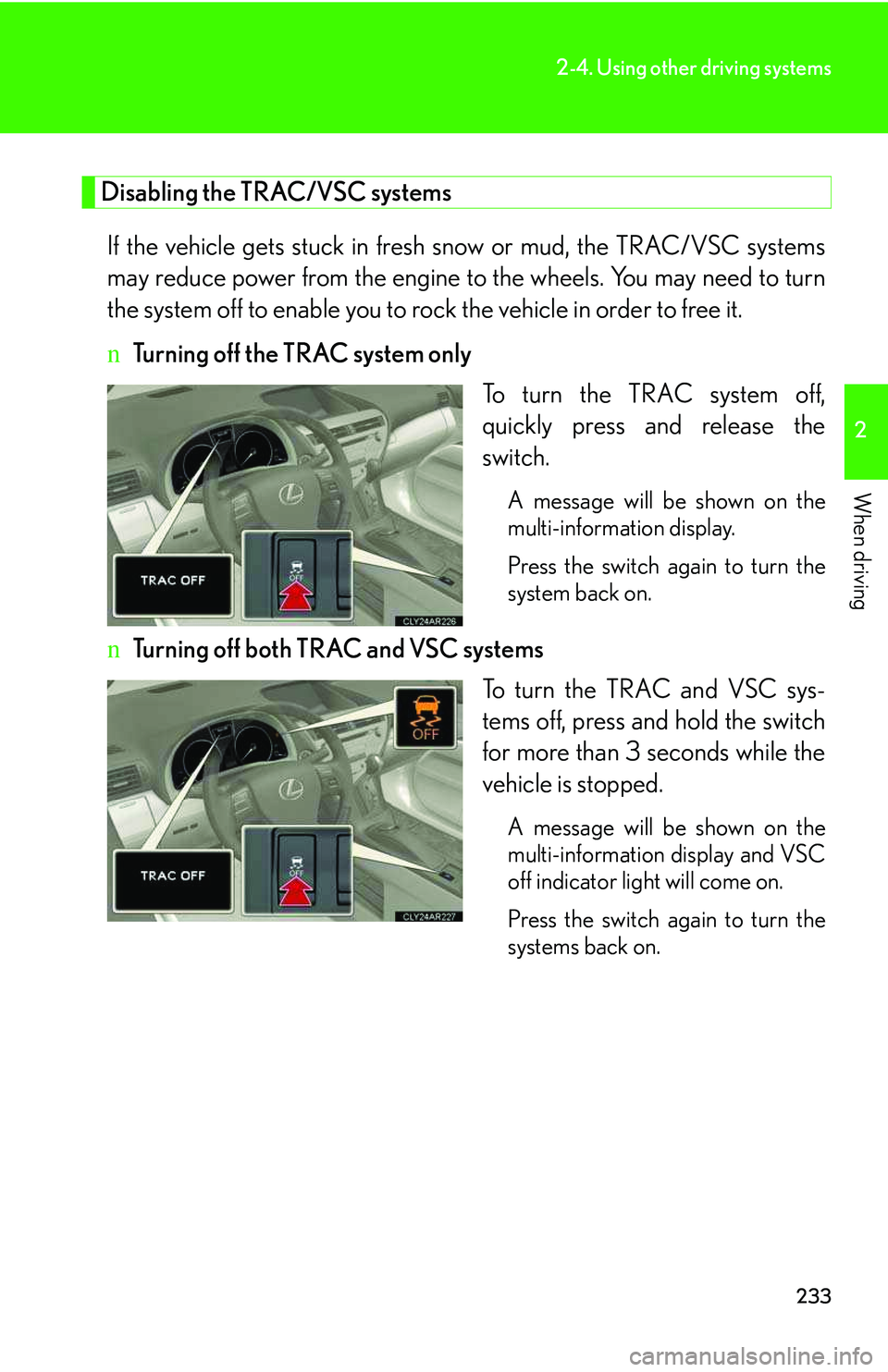
233
2-4. Using other driving systems
2
When driving
Disabling the TRAC/VSC systems
If the vehicle gets stuck in fresh snow or mud, the TRAC/VSC systems
may reduce power from the engine to the wheels. You may need to turn
the system off to enable you to rock the vehicle in order to free it.
nTurning off the TRAC system only
To turn the TRAC system off,
quickly press and release the
switch.
A message will be shown on the
multi-information display.
Press the switch again to turn the
system back on.
nTurning off both TRAC and VSC systems
To turn the TRAC and VSC sys-
tems off, press and hold the switch
for more than 3 seconds while the
vehicle is stopped.
A message will be shown on the
multi-information display and VSC
off indicator light will come on.
Press the switch again to turn the
systems back on.
Page 306 of 821
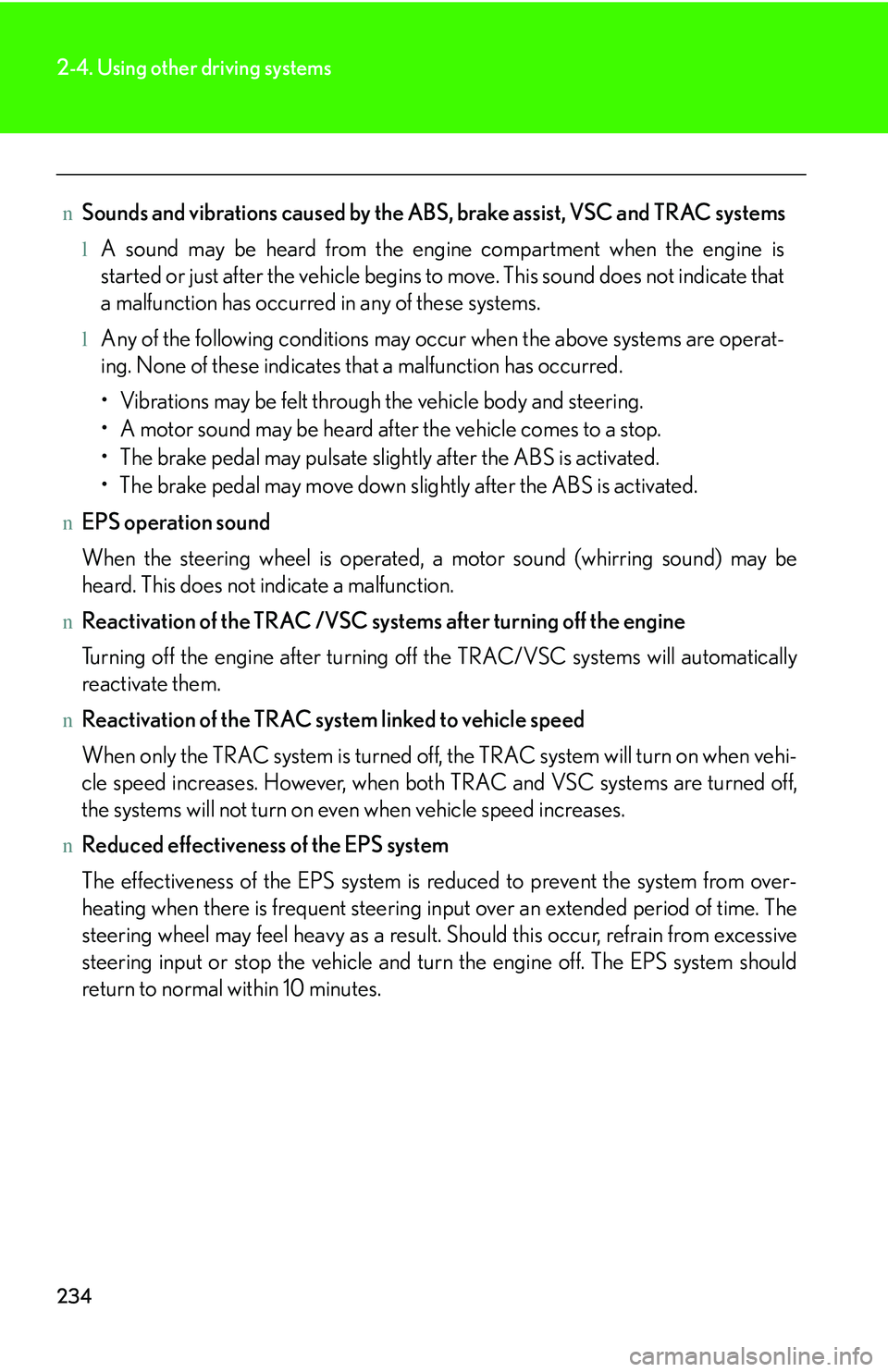
234
2-4. Using other driving systems
nSounds and vibrations caused by the ABS, brake assist, VSC and TRAC systems
lA sound may be heard from the engine compartment when the engine is
started or just after the vehicle begins to move. This sound does not indicate that
a malfunction has occurred in any of these systems.
lAny of the following conditions may occur when the above systems are operat-
ing. None of these indicates that a malfunction has occurred.
Page 307 of 821
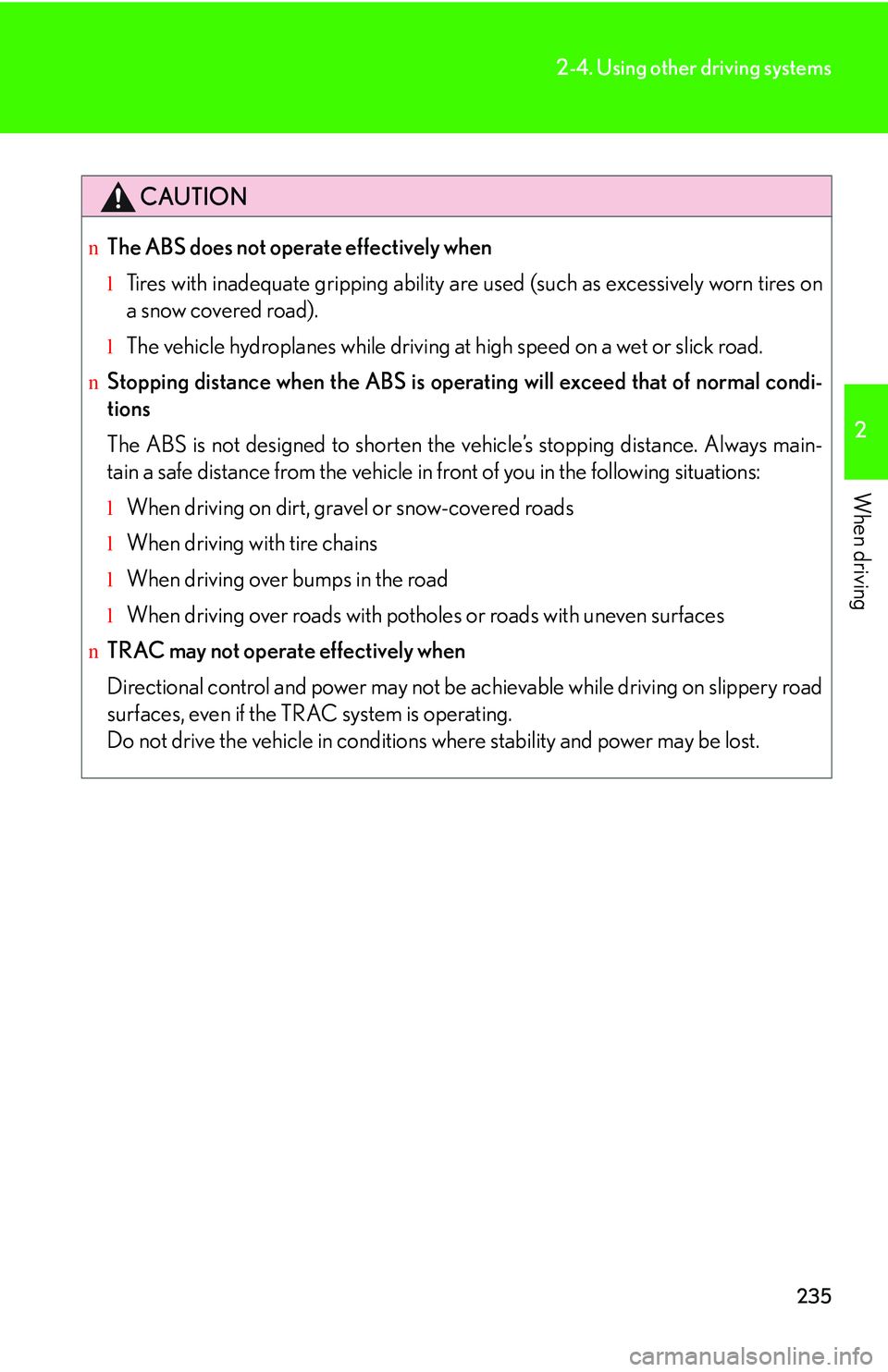
235
2-4. Using other driving systems
2
When driving
CAUTION
nThe ABS does not operate effectively when
lTires with inadequate gripping ability are used (such as excessively worn tires on
a snow covered road).
lThe vehicle hydroplanes while driving at high speed on a wet or slick road.
nStopping distance when the ABS is operating will exceed that of normal condi-
tions
The ABS is not designed to shorten the vehicle’s stopping distance. Always main-
tain a safe distance from the vehicle in front of you in the following situations:
lWhen driving on dirt, gravel or snow-covered roads
lWhen driving with tire chains
lWhen driving over bumps in the road
lWhen driving over roads with potholes or roads with uneven surfaces
nTRAC may not operate effectively when
Directional control and power may not be achievable while driving on slippery road
surfaces, even if the TRAC system is operating.
Do not drive the vehicle in conditions where stability and power may be lost.
Page 308 of 821
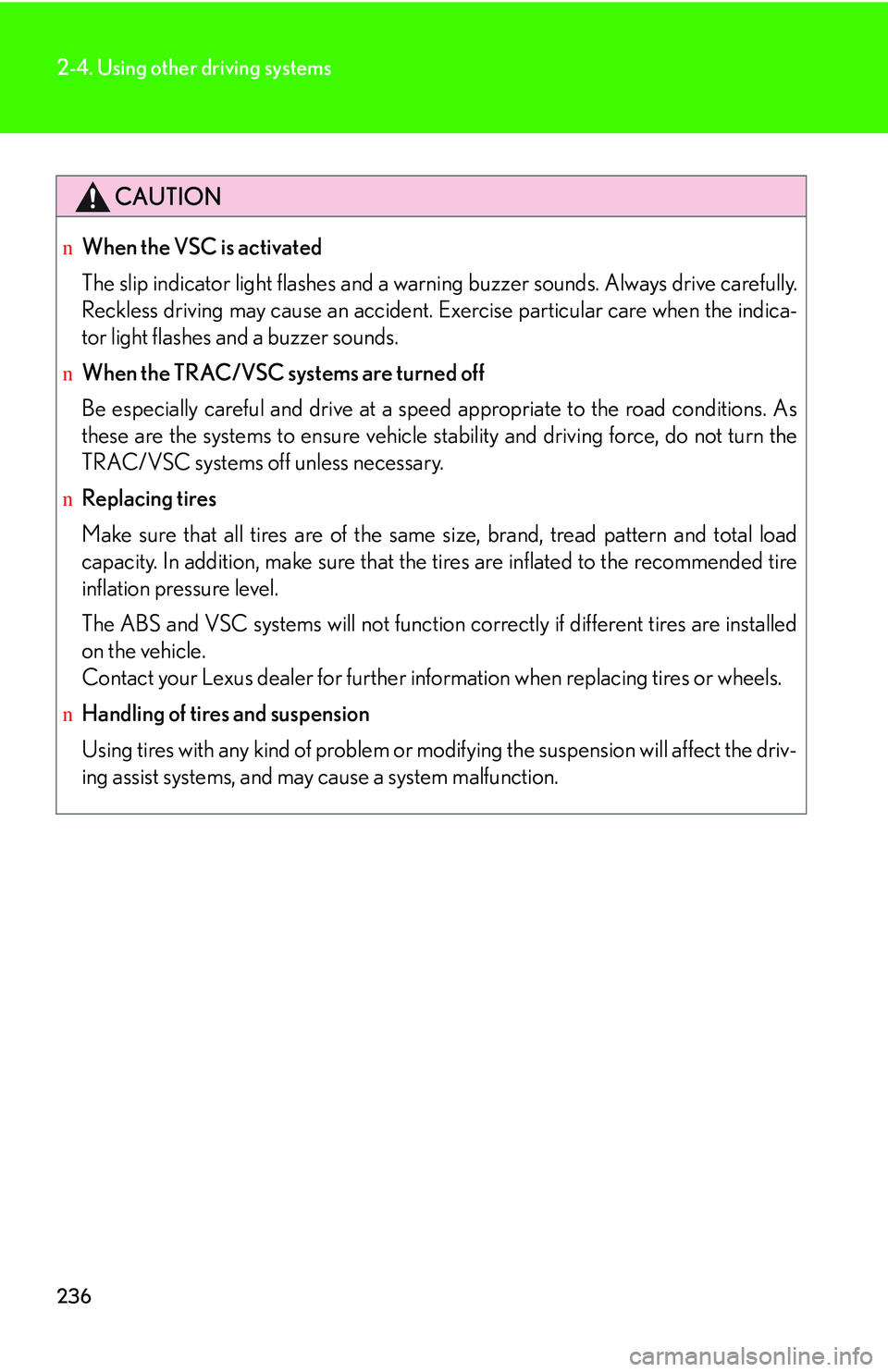
236
2-4. Using other driving systems
CAUTION
nWhen the VSC is activated
The slip indicator light flashes and a warning buzzer sounds. Always drive carefully.
Reckless driving may cause an accident. Exercise particular care when the indica-
tor light flashes and a buzzer sounds.
nWhen the TRAC/VSC systems are turned off
Be especially careful and drive at a speed appropriate to the road conditions. As
these are the systems to ensure vehicle stability and driving force, do not turn the
TRAC/VSC systems off unless necessary.
nReplacing tires
Make sure that all tires are of the same size, brand, tread pattern and total load
capacity. In addition, make sure that the tires are inflated to the recommended tire
inflation pressure level.
The ABS and VSC systems will not function correctly if different tires are installed
on the vehicle.
Contact your Lexus dealer for further information when replacing tires or wheels.
nHandling of tires and suspension
Using tires with any kind of problem or modifying the suspension will affect the driv-
ing assist systems, and may cause a system malfunction.
Page 309 of 821
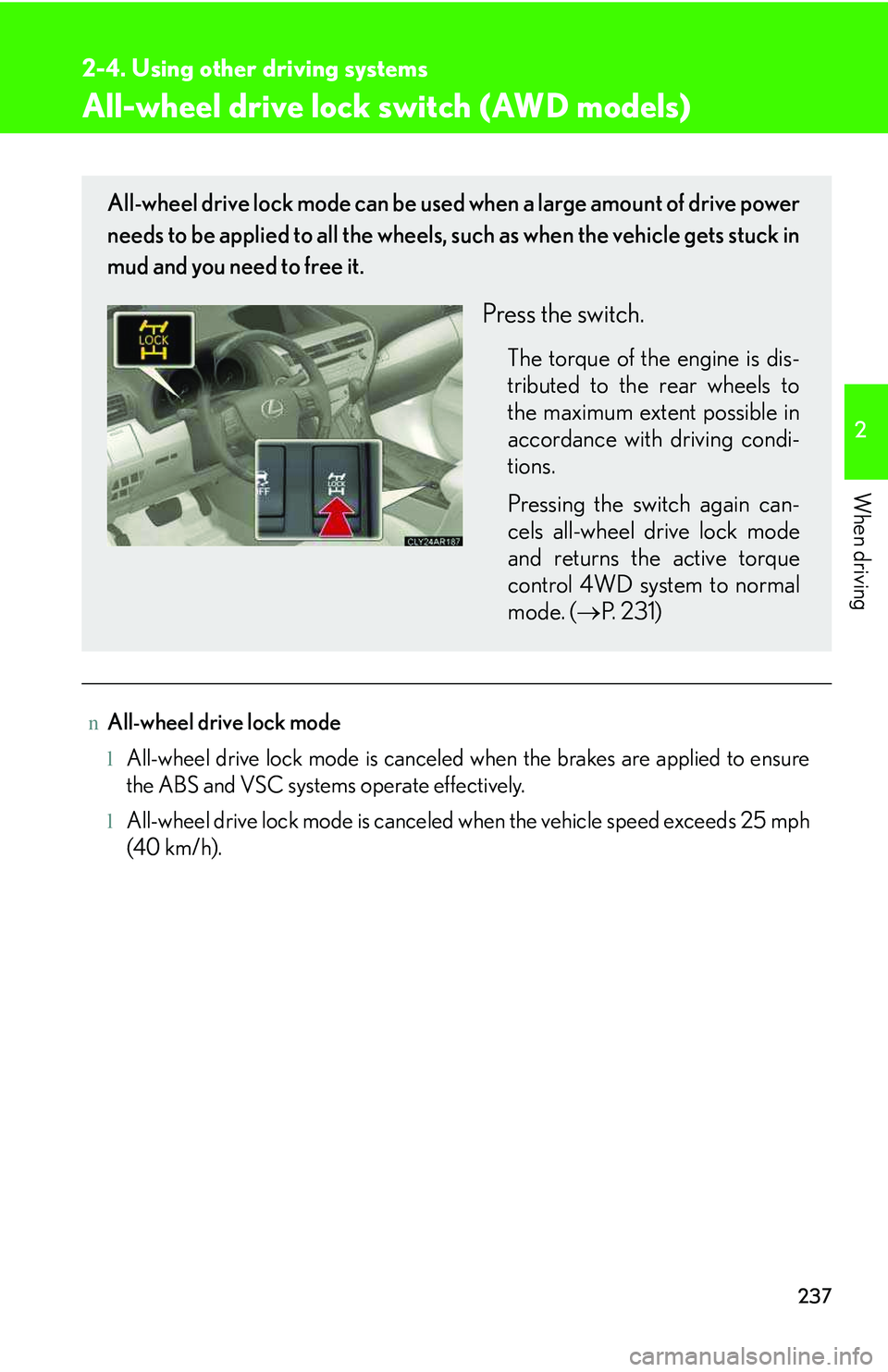
237
2-4. Using other driving systems
2
When driving
All-wheel drive lock switch (AWD models)
nAll-wheel drive lock mode
lAll-wheel drive lock mode is canceled when the brakes are applied to ensure
the ABS and VSC systems operate effectively.
lAll-wheel drive lock mode is canceled when the vehicle speed exceeds 25 mph
(40 km/h).
All-wheel drive lock mode can be used when a large amount of drive power
needs to be applied to all the wheels, such as when the vehicle gets stuck in
mud and you need to free it.
Press the switch.
The torque of the engine is dis-
tributed to the rear wheels to
the maximum extent possible in
accordance with driving condi-
tions.
Pressing the switch again can-
cels all-wheel drive lock mode
and returns the active torque
control 4WD system to normal
mode. (�→P. 2 3 1 )
Page 310 of 821

238
2-4. Using other driving systems
Hill-start assist control
nHill-start assist control can be operated when
lThe shift lever is in a position other than P.
lThe parking brake is not applied.
lThe accelerator pedal is not depressed.
nHill-start assist control
lWhile hill-start assist control is operating, the brakes remain automatically
applied after the driver releases the brake pedal. The stop lights and the high
mounted stoplight turn on.
lHill-start assist control operates for about 2 seconds after the brake pedal is
released.
lIf the slip indicator does not flash and the buzzer does not sound when the brake
pedal is further depressed, slightly reduce the pressure on the brake pedal (do
not allow the vehicle to roll backward) and then firmly depress it again. If the sys-
tem still does not operate, check if the operating conditions explained above
have been met.
Hill-start assist control helps to prevent the vehicle from rolling backwards
when starting on an incline or slippery slope.
To engage hill-start assist con-
trol, further depress the brake
pedal when the vehicle is
stopped completely.
A buzzer will sound once to
indicate the system is activated.
The slip indicator will also start
flashing.